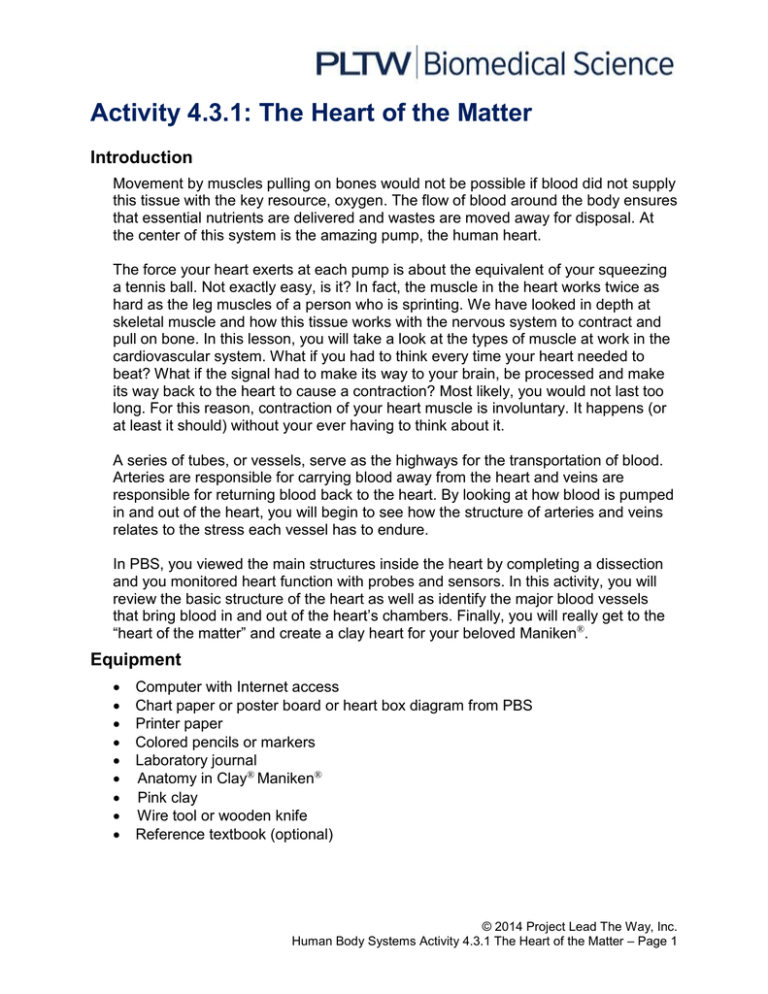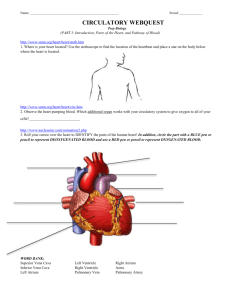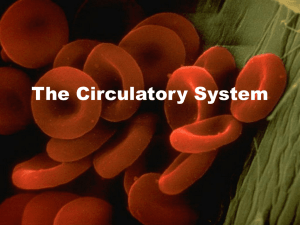A4.3.1.HeartMatter - Life Science Academy
advertisement

Activity 4.3.1: The Heart of the Matter Introduction Movement by muscles pulling on bones would not be possible if blood did not supply this tissue with the key resource, oxygen. The flow of blood around the body ensures that essential nutrients are delivered and wastes are moved away for disposal. At the center of this system is the amazing pump, the human heart. The force your heart exerts at each pump is about the equivalent of your squeezing a tennis ball. Not exactly easy, is it? In fact, the muscle in the heart works twice as hard as the leg muscles of a person who is sprinting. We have looked in depth at skeletal muscle and how this tissue works with the nervous system to contract and pull on bone. In this lesson, you will take a look at the types of muscle at work in the cardiovascular system. What if you had to think every time your heart needed to beat? What if the signal had to make its way to your brain, be processed and make its way back to the heart to cause a contraction? Most likely, you would not last too long. For this reason, contraction of your heart muscle is involuntary. It happens (or at least it should) without your ever having to think about it. A series of tubes, or vessels, serve as the highways for the transportation of blood. Arteries are responsible for carrying blood away from the heart and veins are responsible for returning blood back to the heart. By looking at how blood is pumped in and out of the heart, you will begin to see how the structure of arteries and veins relates to the stress each vessel has to endure. In PBS, you viewed the main structures inside the heart by completing a dissection and you monitored heart function with probes and sensors. In this activity, you will review the basic structure of the heart as well as identify the major blood vessels that bring blood in and out of the heart’s chambers. Finally, you will really get to the “heart of the matter” and create a clay heart for your beloved Maniken®. Equipment Computer with Internet access Chart paper or poster board or heart box diagram from PBS Printer paper Colored pencils or markers Laboratory journal Anatomy in Clay® Maniken® Pink clay Wire tool or wooden knife Reference textbook (optional) © 2014 Project Lead The Way, Inc. Human Body Systems Activity 4.3.1 The Heart of the Matter – Page 1 Procedure Part I: Blood Flow in the Heart 1. Open your laboratory journal to the muscle comparison table you created in Activity 4.2.1. Review information about the three different types of muscle tissue. 2. Answer conclusion questions 1 and 2. 3. Use any of the following websites or a reference textbook to review the structure of the human heart and complete the activity described below. o Human Anatomy Online – Heart http://www.innerbody.com/image/card02.html o Get Body Smart: An Online Examination of Human Anatomy and Physiology http://www.getbodysmart.com/ap/circulatorysystem/heart/menu /menu.html o Texas Heart Institute – Heart Anatomy http://www.texasheartinstitute.org/HIC/Anatomy/anatomy2.cfm 4. Take out the heart box diagram you created in PBS. If you did not complete a heart box diagram in PBS, continue 5. Create in this activity a simplified drawing of the heart to show the basic flow of blood through the organ. This “heart box” will be a general reference for you as you further explore the main blood vessels that serve the body and the heart. It is not designed to show you an anatomical drawing of the heart, but to help you remember key structures as well as the general flow of blood. 6. Obtain a piece of chart paper or poster board. Alternatively, your teacher may have you complete the activity on an 8 ½” x 11” sheet of paper. 7. Use a ruler to create a large 2 x 2 table in the center of the paper as shown below. 8. Think about each square in the box as a chamber of the heart. Label the right and left atria – “RA” and “LA.” Label the right and left ventricle – “RV” and “LV.” Remember: you are looking directly at a person in anatomical position. Make sure you are clear as to which side is labeled as the right and which side is labeled as the left. © 2014 Project Lead The Way, Inc. Human Body Systems Activity 4.3.1 The Heart of the Matter – Page 2 9. Review circulation in the body. Pulmonary circulation moves blood to the lungs to pick up oxygen and back to the heart so this oxygenated blood can be delivered. Systemic circulation pumps oxygen rich blood to the body and returns deoxygenated blood back to the heart to be sent out for refueling. 10. Use a ruler to create a smaller box on either side of the main 2x2. 11. With your partner, determine which side of the heart is responsible for pulmonary circulation and which side is dedicated to systemic circulation. Label the appropriate side box “lungs” and the other box “body.” Add drawings to represent the lungs and the body. 12. Now add the major blood vessels to your diagram. Draw tubes running from one box to another (outside the boxes) to show the path of the vessels listed below. Think about where each vessel starts and ends. For example, the pulmonary arteries move blood from the heart (the right ventricle) to the lungs to pick up oxygen. In this case, you would draw a tube from the box representing your right ventricle to the box representing the lungs. o o o o Pulmonary Artery Pulmonary Vein Aorta Superior and Inferior Vena Cava 13. Label each major blood vessel. Make sure the path you show on your diagram is accurate. 14. Add color to your diagram. Red is traditionally used to show oxygenated blood and blue is used to show blood that is oxygen deficient. Color chambers and vessels according to the type of blood they carry. But remember, this coloring scheme is used to help you visualize differences. Your blood is never blue! Deoxygenated blood is dark red which appears blue when viewed through the skin. 15. Remember that throughout the heart there is a system of valves. Review the structure and function of heart valves using the websites listed in Step 3 or other reliable sources. 16. Add the following valves to the appropriate places on your diagram. Use small lines to show flaps or cusps of the valve. Label each valve. o o o o Tricuspid Valve Mitral (Bicuspid) Valve Pulmonary Valve Aortic Valve © 2014 Project Lead The Way, Inc. Human Body Systems Activity 4.3.1 The Heart of the Matter – Page 3 17. Imagine you are a red blood cell sitting in the right atria of the heart. Write a paragraph that describes what happens to this red blood cell as it moves through the body. What structures will it pass through? How will it interact with oxygen? Make sure to include the word hemoglobin in your response. Think back to what you learned in PBS and to what you learned about oxygen in Unit 3. 18. Note that contraction of the heart muscle is involuntary. Use the Internet or reference textbooks to investigate the conduction system of the heart, the structures that “keep the beat.” The following websites and animations may be helpful. o McGraw Hill – Animation: Conducting System of the Heart http://highered.mcgrawhill.com/sites/0072495855/student_view0/chapter22/animation_ _conducting_system_of_the_heart.html o MyHeartCentral.com – Intrinsic Conduction System of the Heart http://www.healthcentral.com/heart-disease/animation-4472571.html 19. Add the structures of the conduction system to the accurate locations on your diagram. Label each part. 20. Use a yellow or gold arrow to show the direction of electrical communication in the heart. 21. Answer conclusion questions 3-5. 22. Print out a picture of the actual heart structure. Attach this photograph. Keep this picture handy to remind yourself of how the heart actually looks in your chest. Part II: Giving Your Maniken® a Heart 23. Work with your partner to give your Maniken® a heart. Let’s get the blood pumping in your Maniken® and fuel the muscles you built earlier in the unit. Later in this lesson, you will use your knowledge of blood flow to start hooking up the vessels. 24. Form a ball of pink clay (about the size of a quarter) into a short fat carrot. Which chambers does the pointed end of the carrot correspond to? The atria or the ventricles? Refer to the websites on heart structure if you are having trouble visualizing the true shape of the heart. 25. Lay the heart on the tabletop and flatten the back side of the heart just a bit. 26. Using what you know about the structure of the heart, sketch the four main chambers into the clay with a pencil. 27. Note that the heart is responsible for pumping blood to all of the organs of the body, but remember, the tissue of the heart also needs to be bathed in blood. The hard-working muscle needs a constant supply of oxygen. The muscle of the © 2014 Project Lead The Way, Inc. Human Body Systems Activity 4.3.1 The Heart of the Matter – Page 4 heart receives blood through tiny vessels called the coronary arteries. Visualize the system of coronary arteries by looking at the following diagrams: o Texas Heart Institute – Coronary Arteries http://www.texasheartinstitute.org/HIC/Anatomy/coroanat.cfm o National Heart Lung and Blood Institute – The Exterior of the Heart http://www.nhlbi.nih.gov/health/dci/Diseases/hhw/hhw_anatom y.html 28. Use your clay tools or a pencil to carve the following coronary arteries in your clay heart. o o o o Left Coronary Artery (Left Main) Left Anterior Descending Circumflex Artery Right Coronary Artery 29. Roll out a thick piece of pink spaghetti about 1 inch long. You will use this piece of clay to create the aorta. 30. Refer to your heart box and your heart diagram to place this vessel on the heart. 31. Place the end of the spaghetti onto the top of the heart. This piece should stick up like a cherry stem, bend back towards the dorsal side of the heart and run down the back of the organ. 32. Check the placement of the aorta with another group. 33. Locate the diaphragm of your model. The heart will “sit” on the diaphragm. 34. Place the heart in the chest cavity. Pay attention to whether you have the right side or the left side of a Maniken®. Think about how heart placement would be different in each case. 35. Press the heart against the wall to get it to stick. Do not worry about flattening the heart a bit. 36. Check your heart placement with another group and with your teacher. 37. Complete the matching activity found at Pearson Publishing http://media.pearsoncmg.com/bc/bc_marieb_ehap_8/activities/chapter11/A ct11A.html to review heart structure. 38. Answer the remaining conclusion questions. Conclusion © 2014 Project Lead The Way, Inc. Human Body Systems Activity 4.3.1 The Heart of the Matter – Page 5 1. How does the structure of smooth and cardiac muscle differ from the structure of skeletal muscle? 2. Explain how each of the three types of muscle assist with moving blood around the body. 3. What role do valves play in the heart? 4. Which structure in the heart functions as the natural pacemaker? What does this term mean? 5. How does the movement of the electrical impulse relate to the contraction of the chambers of the heart? 6. What is the difference between pulmonary circulation and systemic circulation? © 2014 Project Lead The Way, Inc. Human Body Systems Activity 4.3.1 The Heart of the Matter – Page 6 7. Thinking about function, explain why the left ventricle is much more muscular than the right ventricle. 8. Describe the role of smooth muscle in two human body systems other than the cardiovascular system. 9. How does electrical communication in the heart compare to electrical communication in skeletal muscles? © 2014 Project Lead The Way, Inc. Human Body Systems Activity 4.3.1 The Heart of the Matter – Page 7




